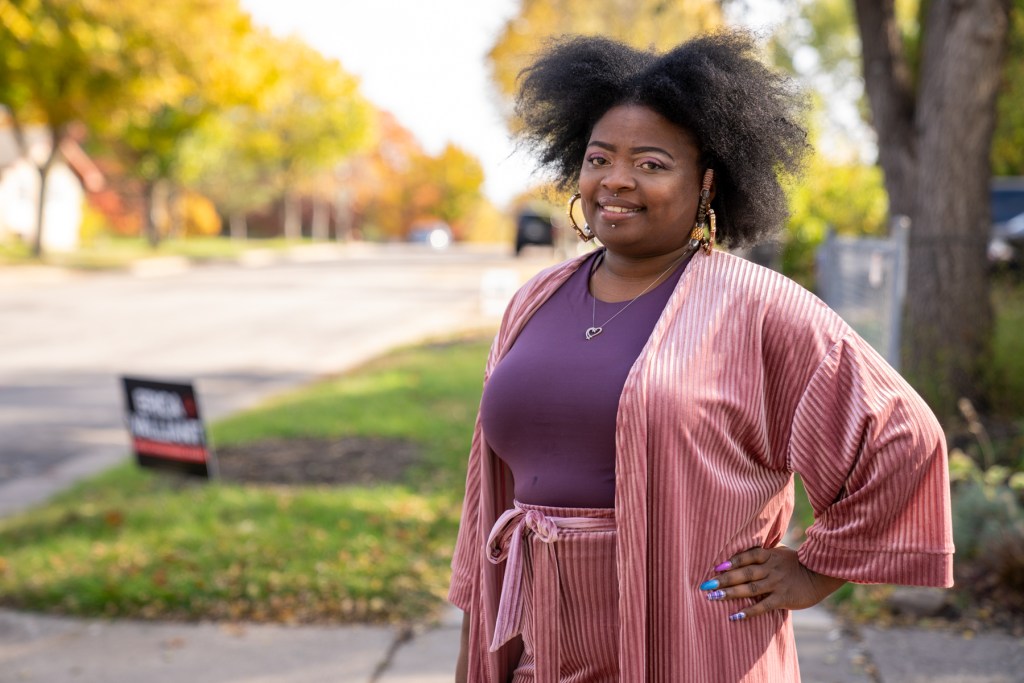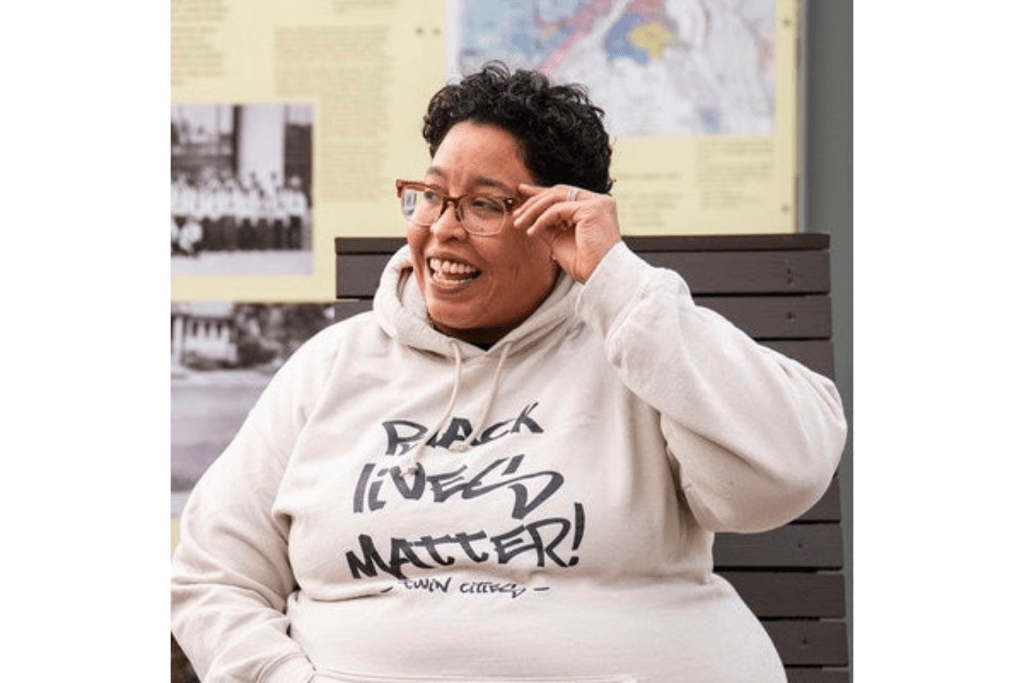Sahan Journal interviewed all seven St. Paul school board candidates: Chauntyll Allen, Yusef Carrillo, Zuki Ellis, Carlo Franco, Abdi Omer, Erica Valliant, and Gita Rijal Zeitler. Voters can choose four.
Name: Yusef Carrillo
Age: 42
Day job: Product analyst in annuities division, Securian Financial
Kids in district: Two boys, a sixth-grader at Highland Park Middle School and a fourth-grader in the dual-language program at Wellstone Elementary
Neighborhood: West End
Yusef Carrillo first served on the St. Paul school board when he was selected to fill a temporary vacancy in 2021. While he filled the role, the administration presented a plan to close five school buildings, including Wellstone Elementary. That placed Carrillo in the unusual position of having to vote on the possible closure of his family’s school. Both his children then attended Wellstone, and his wife works there as a teacher. Ultimately, the board chose to keep Wellstone open, along with two other schools that serve many immigrant families.
Carrillo did not run for election that year. But now he is running for a full term.
“I really want to serve my community,” he said. “I believe that St. Paul deserves to have a top-notch school district that is welcoming to all, that actually helps bridge the educational gaps that exist in our education system.”
He also hopes to change how the board does business and how the district manages schools.
Carrillo characterized the current school-management approach as “slightly Victorian and colonialistic.” Instead, he said, the administration should focus on “empowering our individual schools, to have really strong leadership to help retain teachers, and to make safe environments for our students.”
Why are you running for St. Paul school board?
First of all, I want to serve my community. I believe that St. Paul deserves to have a top-notch school district that is welcoming to all that actually helps bridge the educational gaps. I bring the potential for change in the way that we do business as a board, and I feel very well-positioned and energized to do that.
In 30 seconds or less, why should voters choose you?
First of all, because I have the right heart—as a parent, as a previous school board administrator, as a previous district administrator in Oakland Unified [in California] when I lived there. I know what it takes to make change, and what it takes to change the behavior of people who are working in the district. And as the husband of a lifelong teacher, I truly connect with the actual labor that’s happening in the classroom. I want to see our classrooms succeed.
List three things you think are going well in St. Paul Public Schools.
- For an urban school district, St. Paul is actually doing fairly well in this transformation towards a science-based reading curriculum. I would definitely continue to support it and bolster it if I were elected.
- St. Paul had a huge advantage in the fact that it has a very diverse set of educational programs. That’s something that I want to continue supporting. Our East African magnet school is an example. The reason why we live in St. Paul is because of that dual-language program in Spanish.
- We as a district have not seen the full brunt of enrollment loss that other urban school districts have seen. And we have not seen a sharp rise in charter school enrollment, which is highly linked with steep enrollment loss in school districts. That should give us an opportunity to build and really focus on creating a school district that is very strong.
St. Paul Public Schools has historically seen many kids from immigrant families leave the district for charter schools. What do you think the district is doing well to attract and retain immigrant families, and how should it improve?
Doing well: An example of this is the East African magnet school. The idea that we can have offerings that speak to our diverse communities is important. I think we need to focus a lot on what it is that students are seeking outside of the district. There is unfortunately a tension that is hard to bridge—the tension between having a school that is entirely composed of your community, and having a school that is diverse. Some people really want that diverse experience and some people really do not want that diverse experience. We have to balance that out, and we have to make sure that parents have at least the ability to find schools where they’re going to feel comfortable and where their kids are going to feel comfortable.
Where I think we can definitely improve: Our educators, by and large, do not look like our students. As we go into the future, we need to set up our district to succeed in being able to attract educators who share in the same community, in the same language, in the same ethnic background as our students. That truly makes for a much better educational experience for these families and these communities.
Last year, the district saw a few very scary incidents at schools—including one high school student fatally stabbing a classmate. What do you think the district is doing well in regards to school safety, and what does it need to do differently?
The incident that happened at Harding High School was very concerning. What the school district has gotten down well is building up a corps of people who work as school safety liaisons at the school sites, providing safety, security, and really connecting with students and making sure that they’re not falling through the cracks. I think we need to bolster it. What we’re doing right now is good, but it’s not fully meeting the needs of the community.
We need to increase the amount of school safety liaisons. I was just speaking to my own child, and he’s saying, “Hey, we have three of them in our middle school, and we love them.” So there’s definitely a connection there with the students that makes a big difference. They’re much better equipped than a police department or sheriff’s department to handle and de-escalate situations at schools.
What I think we also can do better, and I think it is going to be a huge undertaking, is fully funding and building a restorative justice program that actually holds students accountable. Currently, restorative justice, unfortunately, is not being fully implemented. The administration hasn’t really provided the funding or the training to be able to do it. I believe we need to step on the accelerator for restorative justice programs that actually make a difference. I have seen it in person: I’ve seen a restorative justice school in California. My wife worked at one. The environment is a huge contrast with the schools that don’t do it. There really is a sense of commitment in the families and the students to uphold community standards. We have an opportunity to widen the scope of what school is in the community and its definition, and be able to reach deep into students’ lives that we haven’t been able to do before.
What’s another issue that would be a priority for you on the school board, and how would you approach it?
We have a problem with engagement in our school district. The administration sometimes makes plans, they may be well-intentioned, but they roll them out as done deals. And then its idea of engagement is to present them to the community, and expect the community to accept it. Real engagement leans more toward co-governance. You have to yield a bit of your decision-making, share your power, with voices that maybe haven’t had it before. Especially in our school district, which has a high population of immigrants, of people who do not speak English as their first language, and who are really learning how government works in the U.S. or maybe have been actively excluded from government.
Engagement is going to be critical for a healthy school district going into the future. A good application for this is our budget. Our budget next year is going to be much different than it was this year. The extra COVID relief funds will sunset. We will face a huge budget shortfall, and for the next few years, St. Paul has to make changes. How do we do that? There has to be a community effort to understand the district’s priorities. And if we do not get the input and connection with the community, it’s going to be frightful for them. That engagement process needs to be baked into the way that we do business.
Correction: Due to an editing error, an earlier version of this article misstated Yusuf Carrillo’s job title.










